Google Nexus 4 Review
Google Nexus 4 Review
Launching Android 4.2 the Nexus 4 offers high-end performance at an amazing price.
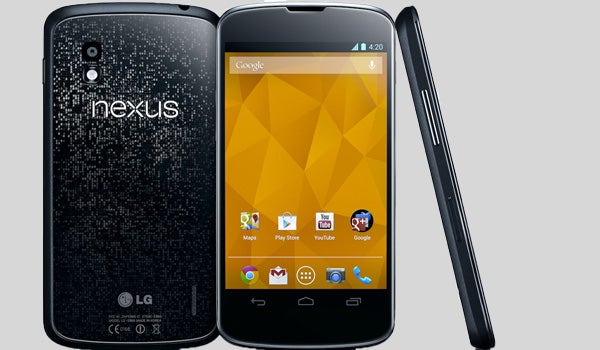
Verdict
Pros
- Staggeringly low price tag
- Android 4.2
- Great Screen
Cons
- Camera could be improved
- Just five homescreens
- Memory not expandable
Key Specifications
- Review Price: £239.00
- Android 4.2 Jelly Bean
- 4.7-inch WXGA IPS display
- Qualcomm Snapdragon S4 Pro quad-core CPU
Google Nexus 4 update
Whether it’s in anticipation of the Nexus 5, or a response to the much rumoured arrival of the iPhone 5C, the Nexus 4 is available to buy for £159. That’s an £80 price cut on the Nexus 8GB model dropping from £239. The price of the 16GB Nexus 4 has also dropped from £279 to £199. To put that into perspective, the quad-core powered Android smartphone is now around the same price as the Nokia Lumia 620.
The Windows Phone 8-running handset is one of the best cheap mobile phones to buy right now, but the Nexus 4 is a great Android alternative. Yes, we know it is only 8GB, but when you consider the great 4.7-inch WXGA IPS display, the fact it runs on Android 4.3 and that sleek, premium design, there’s even more reason to recommend this as one of the best Android phones to buy.
Google Nexus 4 Video Review
Want to see more of the Google Nexus 4? Sit back and watch our video.
MORE: Nexus 6 release date, rumours, features, specs and price
Google Nexus 4 Android 4.3 review
Announced alongside the Nexus 7 2, Android 4.3 is the latest flavour of Google’s Jelly Bean operating system and has been rolling out to Nexus smartphones and tablets.
We’ve already taken a look at Android 4.3 on the Samsung Galaxy Nexus so now we turn our attention to Android 4.3 on the Nexus 4.
The incremental update focuses on making performance improvements including triple buffering, reduced touch latency for gamepads, Bluetooth Smart support, CPU input boost, and a version of Project Butter that runs even smoother. There are some more noticeable upgrades with changes made to the camera app, keyboard and notifications.
There have been some stories about Nexus 4 handsets crashing during the installation process, but we can safely say that the Nexus 4 successfully updated to Android 4.3 with no stability issues whatsoever.
It still offers a slick, fluid experience when swiping through homescreens and a zippy web browsing performance. It still gets a little warm up top where the CPU is located but there’s no sign of the overheating that some Nexus 4 users have complained about.
One of the main areas that Android 4.3 has addressed is the camera app. The on-screen menu system has been redesigned with a new arch shaped look. The volume rocker now acts as a camera trigger and Photo Sphere improves image stitching and exposure levels.
The new menu system makes it much easier and quicker to adjust advanced settings when taking a photo. Photo Sphere is still not the finished article and images can still look a little disjointed in places but there is a notable improvement in the final results.
Some Nexus 4 users have noticed a drop in performance in the gaming department, specifically on less demanding games like Candy Crush. Running the Epic Citadel benchmark tests on the Android 4.3 Nexus 4, it scores a 49.2 average FPS. The Nexus 4 running on Android 4.2.2 in comparison scores a 53.3 average FPS. Clearly there is a difference in the numbers, in reality though giving Candy Crush a play, we didn’t notice any frame rate issues.
Android 4.3 introduces a smarter notifications system offering a greater variety of options to deal with calendar appointments or reminders when they pop up in the notifications bar. Everything appears to be working order here however we did notice that email notifications no longer appear. This has been something reported by some users, so it’s clear this is an issue to be addressed.
Among the other notable features worth pointing out, there’s now a Dialpad Autocomplete to speed up your day-to-day phone use. You can simply start typing a number and matching contacts will appear above. It’s a minor tweak but one that some will find beneficial.
On the whole, Android 4.3 on the Nexus 4 improves an already great Android phone. It tinkers with key features introduced in the first Android Jelly Bean version to great effect. We can confirm a clean bill of health a week from installing and it’s should do more good than bad based on our experiences with the latest Jelly Bean instalment.
Check out all the latest about the Nexus 5 release date, rumours, news, price and specs.
Introduction
The latest addition to Google’s own branded range of Nexus devices, the Google Nexus 4 is manufactured by LG but has the search giant at its core, from the full collection of pre-installed Google applications to the newly revised Android 4.2 Jelly Bean OS.
Although previous Nexus handsets have looked to push the boundaries of the smartphone sector, introducing a collection of new high-end specs previously unseen on portable devices, the Google Nexus 4 has taken a slightly different approach, incorporating a collection of premium specs found on market leading handsets within a body that pleasingly falls at a mid-range price point.
Featuring a quad-core processor, 2GB of RAM and a 4.7-inch 1280 x 768p display, the Google Nexus 4 is on par with the likes of the Samsung Galaxy S3 and Apple iPhone 5 in terms of on-paper specs yet lines up roughly half the price of either device. Available in 8GB and 16GB storage forms, the Google Nexus 4 price starts at a hugely impressive £239, whilst the higher capacity handset lines up at just £279, figures that see the handset as a more wallet-friendly option than the far inferior Sony Xperia P, Motorola Razr i and BlackBerry Bold 9790.
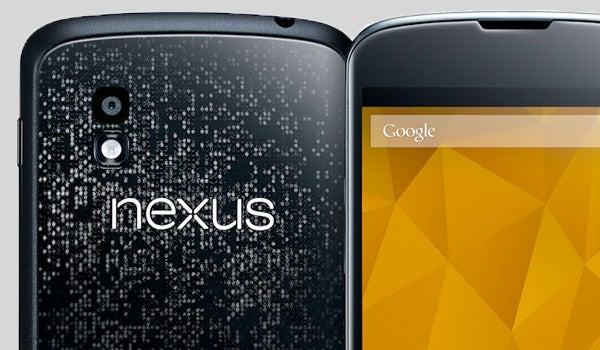
Google Nexus 4 Design
Far from the most desirable handset on the market, the Google Nexus 4 is still somewhat of a looker with relatively svelte design lines and few blemishes detracting from an overall appearance that appeals for the most part but which fails to provide the ‘wow’ factor.
Standard stock black smartphone fair, the Google Nexus 4 design is spruced up by a disco ball effect back that offers a little sparkle to the device. Whilst this feature will not appeal to all, perhaps proving too jazzy or feminine for some, the break from the lifeless black form of the rest of the device is a welcome one and a move which helps, marginally, set the handset apart from a number of its similarly uneventful mid-range counterparts.
Thanks to the handset’s flat black and slick finish, the Google Nexus 4 is someway from being the most comfortable device in the hand. At 4.7-inches in size, despite being just 9.1mm thick, the Google Nexus 4 can feel somewhat clunky with the lack of curves offering a slightly un-ergonomic fit. Despite this slightly awkward stance, however, thanks to rubberised edging, the latest Nexus handset never feels like running the risk of making a premature escape from the hand.
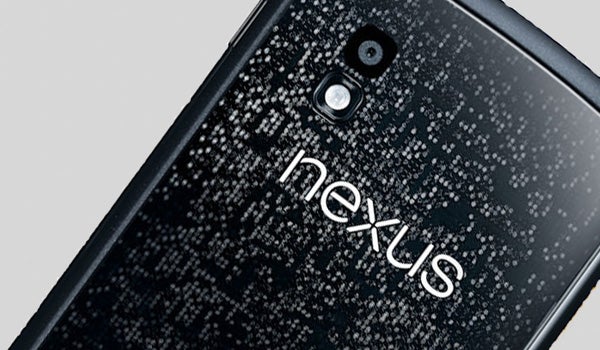
Although feeling safe if somewhat uncomfortable in the hand, the Google Nexus 4 is anything but secure when placed on all but the flattest of surfaces. A niggle that will be familiar to any former or current iPhone 4 and iPhone 4S handset owners, due to the rather plasticy feeling glass backing of the Google Nexus 4, the Android 4.2 device seems intent on making an unwanted sliding exit when placed down on anything other than a perfectly flat, hard surface such as a desktop.
Again in very Apple-esque fashion, and somewhat against the grain of the majority of Android powered handsets, the Google Nexus 4 does not feature a removable back plate, scrapping the option of microSD memory expansion and seeing the handset’s micro SIM inserted via a pop-out side-mounted SIM tray. Another seeming homage to Apple.
With well thought-out button placements ensuring that accidental presses of the physical volume controls or sleep-turn-power button – the only physical buttons found on the device – are avoided when holding the handset in either a landscape or portrait manner, the Google Nexus 4 sadly isn’t without its own hand hitches. When holding the handset in a landscape stance to play app-based games, the Google Nexus 4’s light sensor falls under the hand, causing the device to frequently, unnecessarily, and rather annoyingly, auto adjust the screen’s brightness.
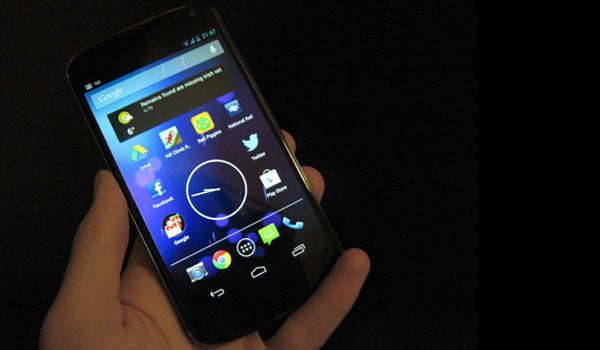
Google Nexus 4 Screen
One of the handset’s many party piece selling points, the Google Nexus 4 screen is a large, expansive, vibrant offering that makes movie absorption on the move a joy and daily tasks an eye appeasing breeze.
At 4.7-inches in size, the 1280 x 768p WXGA IPS Google Nexus 4 screen is just 0.1-inches smaller than the market leading Samsung Galaxy S3, but no less visually impressive. With a pixel-per-inch density higher than that of its Android powered rival, the 320ppi offering of the new Nexus is topped only by the 326ppi image density of the iPhone 5’s Retina display.
With sharp, vibrant colours ensuring that the Google Nexus 4 is a device as comfortable and accomplished at multimedia playback as it is general use, the screen’s expansive viewing angles tick yet another box on the desired features list. Handling extreme viewing angles with aplomb, the Google Nexus 4 screen helps make the device one which can, if desired, be used to share video in a group situation with a couple on a long train journey more than capable of comfortable watching a movie on the device with little concern for performance depleting angle issues.
Partnering with the handset’s 1.5GHz quad-core Qualcomm Snapdragon S4 Pro processor to produce one of the most responsive handset’s on the market, there were occasions when we were forced to take a second stab at registering a link selection whilst on the browser but this is a niggle that we are attributing to the browser more than the screen. That said, the Google Nexus 4 comfortably features one of the most visually impressive smartphones screens currently available at a mid-range price point.
More than just a visually impressive offering, the Google Nexus 4 screen is a reassurance to more clumsy users with the Corning Gorilla Glass 2 coating ensuring that the device is protected against the unavoidable collection of knocks, drops and bumps that accompany any handset’s lifespan. Whilst we didn’t subject the Google Nexus 4’s screen to too much rough treatment during our time with the device, placed in a pocket for a couple of days with a collection of coins and keys, the device showed no physical or image depleting sign of the continued and unwanted contact.
Google Nexus 4 Interface and Usability
With Nexus devices famed for whipping up some smartphone and tablet excitement by launching the latest iteration of Google’s mobile OS, the Google Nexus 4 is no different, lining up as the first device to come pre-installed with the revised Android 4.2 Jelly Bean operating system.
Despite being more of a minor revision than a grand refresh, the latest Android system, which builds on the Google Nexus 7 launched Android 4.1 Jelly Bean offering, Android 4.2 remains a joy to use and one which transforms a collection of high-end hardware into a consumer appeasing, user experience defining option that, thanks in part to its staggeringly impressive £239 price tag, is sure to rejuvenate the smartphone sector.
Whilst in the future, smartphone manufacturers such as Samsung, HTC and Sony will no doubt skin the new Android 4.2 OS in their custom UI’s, for the Google Nexus 4, the system is at its raw best. With a Google search bar locked in place front and centre, Google has made its presence felt in the Nexus 4, filling the device with the full collection of Google branded applications from the standard and extremely useful Gmail and Google Maps, to the increasingly present but still little used Google Plus.
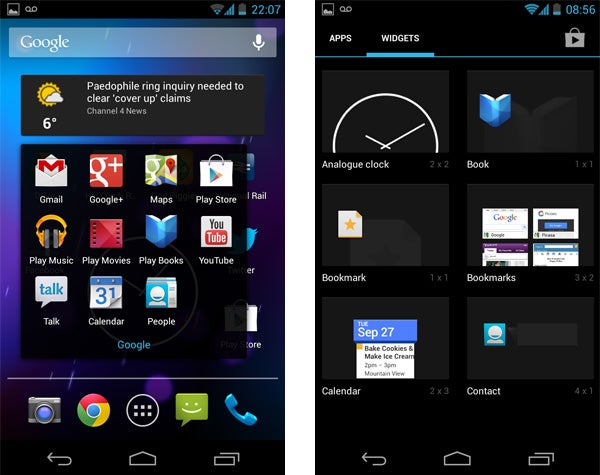
Although the new features introduced in Android 4.2 do not feature front and centre on the Google Nexus 4, such as the new keyboard with swipe input or the Photo Sphere camera option, core Android values such as heavy customisation certainly do. Customisation of the Google Nexus 4 is, as always with Android handsets, a breeze with apps and widgets easily pinned and moved across the collection of side scrolling homescreens.
Disappointingly stifling these customisation options somewhat, however, the Google Nexus 4 offers up just five homescreens, down on some Android handsets and a space that can quickly become limiting when setting up your device to offer instant widget-based access to the likes of email, Twitter feeds, music playback and more.
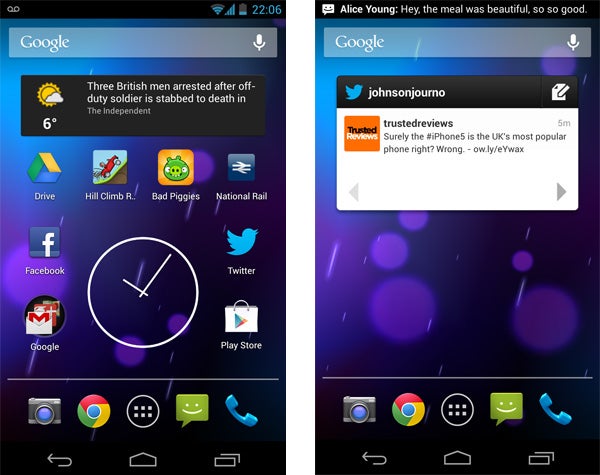
With the 1.5GHz quad-core CPU once again ensuring a zippy and hitch free experience, opening applications is met with little fuss or fanfare, just speedy, efficient launching. A similar level of hassle-free speed can be found when switching between applications using Android’s multitasking features, jumping back to the homescreen or when riffling between the multiple menus and homescreens.
Enhancing usability with a smoother, more fluid user experience, Android’s drag down notification bar remains in 4.2 Jelly Bean, with the interface addition offering, instant app-free access to a whole raft of important information from incoming messages and emails to download alerts. What’s more in the Google Nexus 4 launching OS, Google has taken note of manufacturer’s UIs and made a selection of handset settings such as Wi-Fi setup available at will, a welcome and time saving addition.
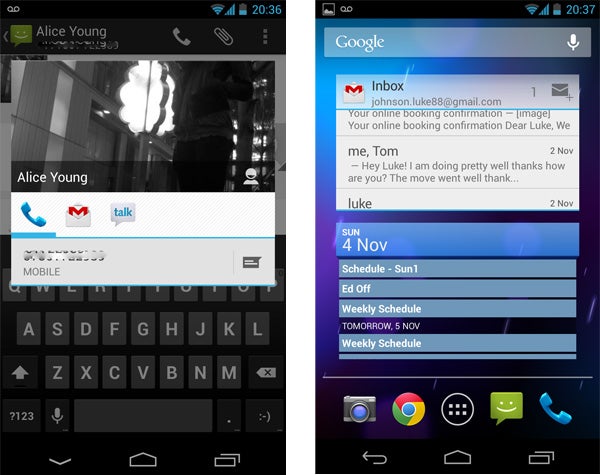
Google Nexus 4 Contacts, Calling and Browser
Despite the recent influx of increasingly advanced smartphone bells and whistles, from Full HD video recording capabilities to integrated MP3 players, the ability for a handset to simply and successfully make and receive calls is still its most core and fundamental ability, yet one that is being increasingly overlooked by manufacturers as specs sheet defining features take increasing precedence.
Call quality on the Google Nexus 4, however, is extremely impressive with LG and Google clearly making an effort to ensure than the handset’s bread and butter is not an oversight that suffers at the expense of more luxurious inclusions. With strong, easy to alter volume controls, the Google Nexus 4 boasts noise cancelling features ensuring that you can be heard, and hear the other end of the conversation, even when in load, busy, bustling areas.
Not just an impressive on-paper addition, the handset’s noise cancelling abilities worked exceptionally well in practice, allowing us to conduct conversations next to a busy road, in a noisy pub and even at a football ground with minimal disruption.
As with virtually all Android handsets, the Google Nexus 4 contact features are a simplistic joy to use with contacts stored on your Google account seamlessly pulled through whilst others can be added manually or via the likes of Facebook integration. Well laid out and easy to navigate, the contacts menus allows for multiple means of communication from the standard call or SMS to email or even via social streams including of course Google Plus.
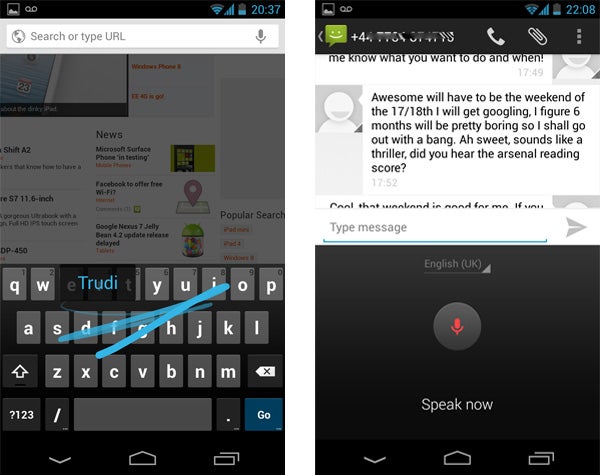
Constructing messages using the Google Nexus 4, be they SMS or email is a hit and miss affair. Whilst the newly introduced keyboard with swipe functionality, a feature that will be pleasingly familiar to users of the Samsung packed Swype service, is a sure fire hit, the voice dictate service is a little less efficient. Struggling with multi-syllable words, the auto dictate services quickly become more of a frustrating hindrance than a time saving help. In contrast, however, the swipe feature, which allows you to drag your finger across the QWERTY offering to spell your desired words, is a joy to use. Offering a quicker input method for longer SMS messages, emails and note taking, swipe proves impressively accurate in practice, with highly impressive predictive capabilities.
Turning to the browser and, unsurprisingly, Google has opted to fill the Google Nexus 4 with its own branded Chome offering. This is far from a bad thing though with Chrome offering one of the most pleasing and easy to use browser options around, be it from a desktop or mobile device.
With multi-tabbed browsing ensuring you can view, and jump between multiple windows with little fuss, the Chrome browser is still not the perfect option. Whilst those looking to access Flash content might be a little disappointed, as mentioned previously, we, on occasion, had issues with the browser accepting our input options, a slight issues that with time could become quite the irritant.
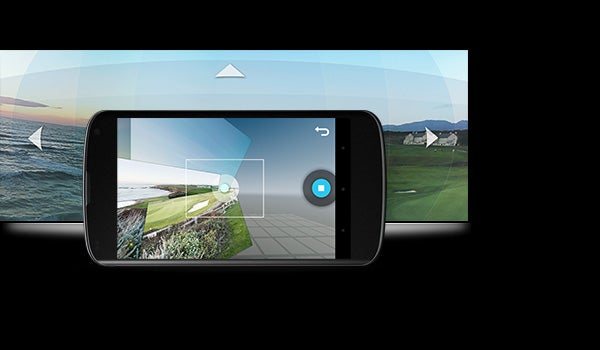
Google Nexus 4 Camera
The Google Nexus 4 camera collection made up of two parts, with a 1.3-megapixel forward facing snapper partnered with the now seemingly industry standard 8-megapixel camera on the rear. Although smartphone integrated cameras are still a long way from being a true replacement to a dedicated compact in terms of performance, following the strong showing of its other key elements, the Google Nexus 4 camera can’t help but disappoint.
On the whole, the 8-megapixel rear-mounted camera found on the Google Nexus 4 is somewhat lacklustre. Whilst focus speeds and shutter speeds are impressive, and you can quickly open the camera app direct from the lock screen, ensuring you will always be supported when trying to capture that fleeting magic moment, in terms of overall results, images frequently prove below expectations. With snaps appearing excessively flat, contrast ratios leave much to be desired with block colours offering little gradient or subtlety in shading.

Whilst the integrated LED flash struggles with levelling, often whiting out content when in use, as with most smartphone cameras, sampling the Nexus 4’s digital zoom is a recipe for disaster, causing snaps to come out excessively graining and with lifeless, block colours.

Thanks to the handset’s Android 4.2 Jelly Bean innards, the Google Nexus 4 plays host to the operating system’s new feature Photo Sphere. An exaggerated version of a panorama shot, the new Photo Sphere functionality lets you take 360-degree snaps in all directions, stitching together a collection of stills into a single scrollable image that offers an immersive and rounded picture.
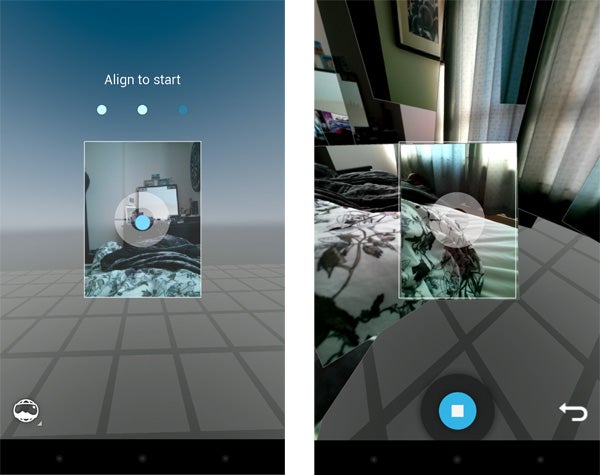
Despite being one of the most high-profile additions to Android 4.2 Jelly Bean over its 4.1 sibling, Photo Sphere is far from a new service with similar features having been made available for some time via a selection of downloadable apps such as 360Panorama by Occipital. Easy to use and with largely strong results, assuming you have a steady hand and considerable patience, it is possible to create some quite impressive and enjoyable shots that can be explored on screen.
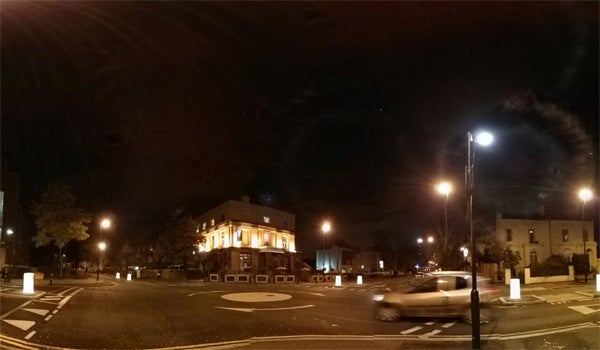
Further enhancing the Google Nexus 4 camera capabilities, the LG manufactured handset comes pre-loaded with a selection of editing features including a host of post-production filters and a raft of tools allowing you to alter expose levels, effect levels and of course, crop images to desired content and sizes. All relatively standard fare but a welcome addition nonetheless.

As with the stills offering the Google Nexus 4 video recording capabilities are acceptable without setting the world alight. Capable of capturing 1080p Full HD content, the Google Nexus 4 is once again rivalling the top-end handsets such as the HTC One X and iPhone 5 with the handset’s video recorder also offering the option of capturing stills images whilst in the midst of recording video.
This judgement of the Google Nexus 4 camera offering is made overly critical by the handset’s strong performances across the board. On any other handset priced at the mid-range market, this 8-megapixel would be more than satisfactory, on the Nexus 4, however, it feels like a small chink in an otherwise all-encompassing and impressively strong armour.
Google Nexus 4 Multimedia
With the Google Nexus 4 being made available in just 8GB and 16GB storage forms, neither of which are compatible with microSD expansion found on most Android handset, for some, the limited storage capacity of the handset will mean that it is not ideal for the multimedia heavy user. If you can put the potential storage issues aside, however, the handset is a multimedia loving joy.
Thanks to the expansive 4.7-inch, 1280 x 768p 320ppi display, the Google Nexus 4 becomes a pleasure to watch high-quality video content on. Whilst some handsets are limited by slow refresh rates, poor colour management or tinny sound, the Google Nexus 4 shrugs off all of these issues, lining up as one of the most visually impressive devices on the market, at any price point.
The inbuilt speakers found on the Google Nexus 4 are surprisingly strong making movie playback and out loud podcast absorption not only possible but a largely enjoyable experience. Although largely strong, the handset’s inbuilt speaker does struggle with distortion and rattle on occasion when music playback hits the highest volume settings.

Winning the Google Nexus 4’s inbuilt speaker added brownie points, Google and LG have positioned the audio provider well on the handset’s rear lower-right corner. Positioned just out of reach of your hand when holding the device in a conventional landscape or portrait manner, the speaker’s location only becomes an issue for disrupted and muffled playback when placed down on its rear on a flat or soft surface.
Elsewhere, thanks to the heavily stacked Google Play Store, the Google Nexus 4 can quickly and easily be brimmed with high-quality music, video and of course app based content. Those not looking to splash the cash through the Google outlet, however, a simple drag-and-drop method can be used to fill the device with high quality video and audio content.
Whilst homescreen based widgets help keep multimedia content at the fore of the handset’s being, there is further indication beyond the handset’s limited storage that the Google Nexus 4 has a less than multimedia centric ilk. With the handset not coming boxed with the customary pair of complementary in-ear headphones, Google has made a move that, whilst helping keeping the handset’s hugely impressive price point low, will be sure to surprise some adopters.
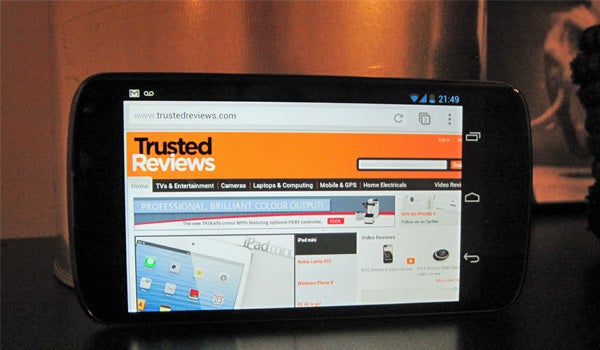
Google Nexus 4 Battery Life and Connectivity
Despite featuring a hefty 2,100 mAh Lithium polymer battery, we found the Google Nexus 4 battery life left a lot to be desired, with the expansive 4.7-inch display and 1.5GHz quad-core processor proving a considerable drain on the handset’s power supply. With the Android 4.2 handset repeatedly fail to clear the one day usage hump that plagues so many devices, Google and LG have lined the Nexus 4 up in parallel to its competitors without pushing the boundaries.
What’s more, as well as suffering from rapid battery drain, an issue that is unsurprisingly rapidly accelerated when making use of app-based games or multimedia consumption, the Google Nexus 4 is less than speedy to recharge. With a charge from 15 per cent battery to 100 per cent battery pushing the three hour mark, daily overnight charges are a likely outcome if adopting the latest Nexus handset.
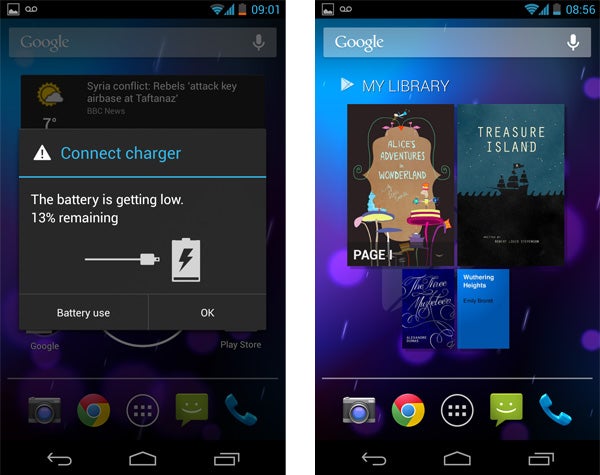
What the Google Nexus 4 loses in battery life, it more than makes up for in its connectivity options. Uniformly making use of a microUSB connection port for charging, the handset’s collection of connectivity features is further bolstered by the expected Wi-Fi 802.11, HSPA , Bluetooth and 3G options whilst NFC also makes an appearance.
Packing NFC connectivity features, thanks to Android Beam allows users to wireless transfer details and data between compatible handsets simply by bumping them together. Whilst the current potential uses for integrated NFV are currently fairly limited, in the very near future this technology is expected to explode with handsets replacing the likes of bank and travel cards as a contactless means of low value payment.
On top of this, Google has confirmed that the Nexus 4 is compatible with wireless charging, a feature that although we have as yet been unable to test, will be made possible in the near future with compatible accessories.
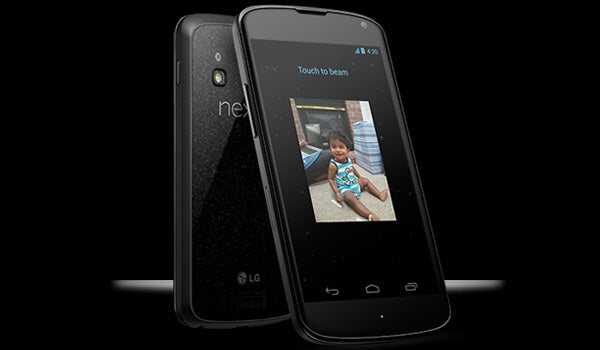
Google Nexus 4 Verdict
Unlike a selection of Google’s previous Nexus branded devices such as the Samsung Galaxy Nexus, the Google Nexus 4 is not the latest dominant force in the ever crowed smartphone sector. That doesn’t mean that it isn’t still a game changer, however.
With a specs sheet rivalling, but not eclipsing, some of the leading high-end handsets currently on the market, but with a SIM-free price tag more akin to a mid-range device, the Google Nexus 4 is a device that is pushing the boundaries of smartphone capabilities, bringing hugely impressive performances to a wider market.
Featuring a screen that is nothing short of stunning, a processor that will keep things running along quickly and smoothly, and an operating system that is a simplistic joy to use, the Google Nexus 4 is a highly recommended handset for those wanting to join the high-end handset revolution. What’s more, inescapable is the handset’s staggeringly low £239 price tag. If other manufacturers are forced to follow suit with high-end, low-priced devices, the Google Nexus 4 will truly have changed the smartphone market for the better, in consumers eyes at least.
How we test phones
We test every mobile phone we review thoroughly. We use industry standard tests to compare features properly and we use the phone as our main device over the review period. We’ll always tell you what we find and we never, ever, accept money to review a product.
Trusted Score
Score in detail
-
Performance 9
-
Camera 7
-
Design 8
-
Usability 9
-
Value 10
-
Features 9
-
Screen Quality 9
General
| Operating System | Android OS |
| Height (Millimeter) | 133.9mm |
| Width (Millimeter) | 68.7mm |
| Depth (Millimeter) | 9.1mm |
| Weight (Gram) | 139g |
| Available Colours | Black |
Display
| Screen Size (inches) (Inch) | 4.7in |
| Screen Resolution | 1280 x 768 |
| Touchscreen | WXGA IPS |
Storage
| Internal Storage (Gigabyte) | 16GB |
| Expandable memory | No |
| Camera (Megapixel) | 8 Megapixel |
| Front Facing Camera (Megapixel) | 1.3MP Megapixel |
| Camera Flash | LED |
Processor and Internal Specs
| CPU | 1.5GHz quad-core Qualcomm Snapdragon S4 Pro |

